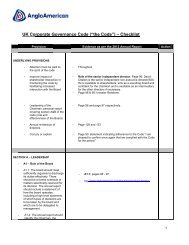pdf [ 1.5MB ] - Anglo American
pdf [ 1.5MB ] - Anglo American
pdf [ 1.5MB ] - Anglo American
You also want an ePaper? Increase the reach of your titles
YUMPU automatically turns print PDFs into web optimized ePapers that Google loves.
Scaw Metals Group Annual Report 2005<br />
Scaw Metals Group Sustainable Development Report 2005<br />
39<br />
6<br />
environment case studies<br />
Hyperspectral Images<br />
The remote sensing component of the Rietfontein remediation<br />
project, which is complementing the ground based<br />
monitoring of the project, has been completed. The project<br />
was a collaboration between the Witwatersrand University<br />
(Johannesburg, South Africa), Tel Aviv University (Tel Aviv,<br />
Israel) and Bar-Kal Systems Engineering Ltd (Israel).<br />
Rietfontein Area B<br />
Landfill<br />
The hyperspectral images provide an indication of healthy<br />
plant growth, the presence of certain types of pollutants<br />
and leachate generation. At a glance the hyperspectral<br />
images will be able to illustrate the effectiveness of the<br />
ecological engineering approach used to remediate the<br />
Rietfontein Area B Landfill.<br />
Hyperspectral Remote Sensing Thematic Images were used<br />
as a method of monitoring the presence of vegetation and<br />
mineral contamination on site. The aerial survey was<br />
undertaken at:<br />
47 620 m (resolution: 3 x 3 metre pixels)<br />
43 048 m (resolution: 1.6 x 1.6 metre pixels)<br />
The aerial survey was complemented with soils and mineral<br />
ground truthing. In addition, the NASA Terra Satellite (Aster)<br />
provides the platform for Aster Hyperspectral Remote<br />
Sensing Thematic Images for vegetation and mineral<br />
contamination. This served as the Aster baseline for the<br />
Rietfontein Landfill, in comparison with surrounding footprints<br />
from mining activities. In this context, the presence of<br />
minerals was not detected.<br />
A hyperspectral image of the Rietfontein Landfill site - low<br />
altitude vegetation fraction.<br />
Giant Bullfrog<br />
Since the remediation started on site, two giant bullfrogs<br />
were observed. The giant bullfrog is the second largest<br />
frog in Africa. It buries itself underground only to emerge<br />
after approximately 50mm of rainfall. It stays above ground<br />
for a brief period to feed, after which it again buries itself.<br />
The giant bullfrog is therefore rarely observed. In fact, it<br />
spends most of its 35 to 40 year life span underground.<br />
The giant bullfrog can reach over 20cm in length.<br />
The World Conservation Union has listed the giant bullfrog<br />
as near-threatened in Southern Africa. The information<br />
collected on site will be used to better understand the giant<br />
bullfrog behaviour. Professor Graham Alexander, a zoology<br />
professor at the University of the Witwatersrand, has done<br />
extensive work on the giant bullfrog and will be monitoring<br />
the amphibians in the area.<br />
He may not be much of a size now, but this baby giant bullfrog<br />
grows to over 20cm in length to achieve the status of being<br />
the second largest frog in Africa. Since remediation started on<br />
Rietfontein Area B Landfill, the giant bullfrog has been found<br />
on the site.


![pdf [ 1.5MB ] - Anglo American](https://img.yumpu.com/34179502/41/500x640/pdf-15mb-anglo-american.jpg)
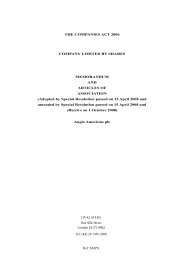
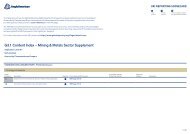
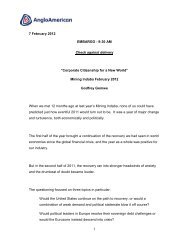
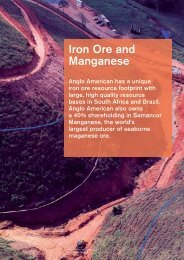
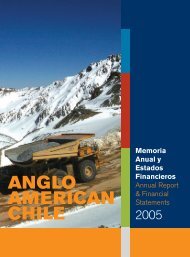
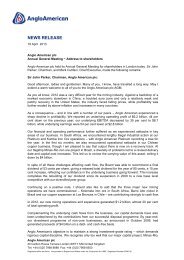
![English PDF [ 189KB ] - Anglo American](https://img.yumpu.com/50470814/1/184x260/english-pdf-189kb-anglo-american.jpg?quality=85)
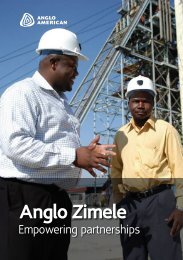

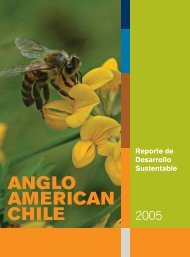

![pdf [ 595KB ] - Anglo American](https://img.yumpu.com/49420483/1/184x260/pdf-595kb-anglo-american.jpg?quality=85)
![pdf [ 1.1MB ] - Anglo American](https://img.yumpu.com/49057963/1/190x240/pdf-11mb-anglo-american.jpg?quality=85)
